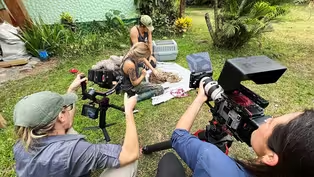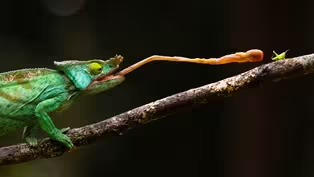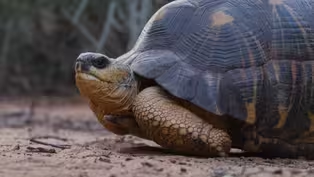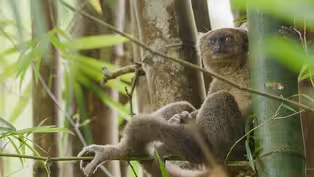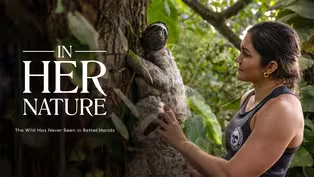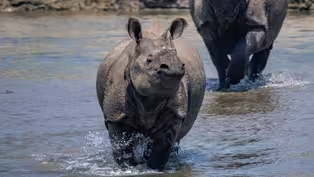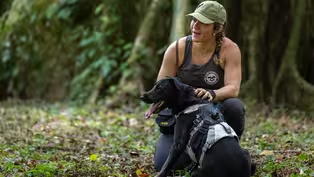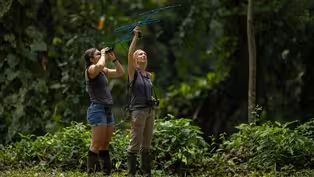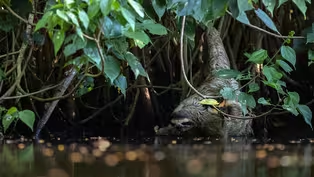
Saving The Slowest Mammal on Earth | In Her Nature
Special | 37m 46sVideo has Closed Captions
A sloth scientist, her tree-climbing BFF, and their dog work to save Costa Rica’s sloth populations.
A sloth scientist, her tree-climbing BFF, and their dog work to save Costa Rica’s sloth populations in groundbreaking ways, all while capturing rarely seen wild sloth behaviors and reimagining what it means to be a woman in conservation.
Problems playing video? | Closed Captioning Feedback
Problems playing video? | Closed Captioning Feedback
Major support for NATURE is provided by The Arnhold Family in memory of Henry and Clarisse Arnhold, Sue and Edgar Wachenheim III, The Fairweather Foundation, Charles Rosenblum, Kathy Chiao and...

Saving The Slowest Mammal on Earth | In Her Nature
Special | 37m 46sVideo has Closed Captions
A sloth scientist, her tree-climbing BFF, and their dog work to save Costa Rica’s sloth populations in groundbreaking ways, all while capturing rarely seen wild sloth behaviors and reimagining what it means to be a woman in conservation.
Problems playing video? | Closed Captioning Feedback
How to Watch Nature
Nature is available to stream on pbs.org and the free PBS App, available on iPhone, Apple TV, Android TV, Android smartphones, Amazon Fire TV, Amazon Fire Tablet, Roku, Samsung Smart TV, and Vizio.
Buy Now
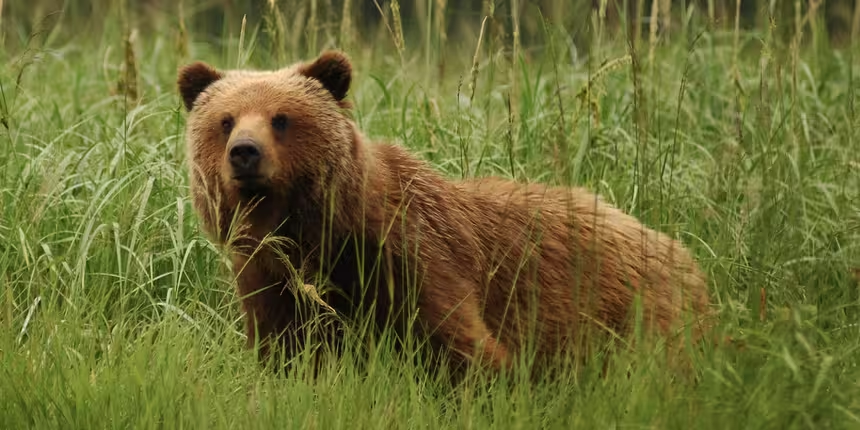
Explore More Ways to Watch
Bring the beauty and wonders of wildlife and natural history into your home with classic NATURE episodes.Providing Support for PBS.org
Learn Moreabout PBS online sponsorshipMore from This Collection
The Women Behind the Wild | In Her Nature
Video has Closed Captions
Go behind the lens with the making of 'In Her Nature.' (30m 40s)
The Chameleon Queen | In Her Nature
Video has Closed Captions
Despite cultural taboos, herpetologist Fandresena Rakotoharimalala is determined to save chameleons. (13m 25s)
The Slowest Stampede on Earth | In Her Nature
Video has Closed Captions
In the otherworldly Spiny Forest of Madagascar, a historic release is about to take place. (19m 31s)
Saving the World’s Rarest Lemurs | In Her Nature
Video has Closed Captions
Greater bamboo lemurs, recently thought to be extinct, are critically endangered. (22m 1s)
Series Trailer | In Her Nature
Video has Closed Captions
Meet the courageous women shaping wildlife conservation. (1m 25s)
The Rhino Whisperer | In Her Nature
Video has Closed Captions
The story of Nepal's first female nature guide and her fight to save the country's wildlife. (20m 51s)
Providing Support for PBS.org
Learn Moreabout PBS online sponsorshipTamara and I are definitely opposites.
Our shared obsession with wildlife is what really brought us together.
And at the heart of our friendship is the sloth.
The most important thing is to realize that whoever they are, wherever they live, their lives make a difference.
In the wildest corners of our Earth, women are still making a difference.
Their courage is saving species and welcoming a new era of coexistence.
But what ignites this passion?
My guess is... it's simply in her nature.
Look!
You've got those two mating, definitely, they're on top of each other.
- Ew They love each other.
How many have you got?
We've got about, about 93.
We're not sure all together.
I grew up loving nature.
But I lived in a city, so there was really limited interaction that I could have with wildlife.
Hey, Dad!
When I was finishing my PhD, I really wanted to spend more time working, on protecting the species that I love so much.
Girls grow up thinking that maybe there's no place for them working in the middle of the jungle.
And I think because I like to wear makeup and I like to wear pretty dresses, people do not take me seriously.
But now I've learned to take advantage of it, use it as my power.
I don't think I'd be as successful if I hadn't been underestimated.
I love climbing trees.
I just love to be in the tree, like, I could be up there for hours.
I'm Tamara.
I'm living in Costa Rica since, like, eight years.
Becky and I met here in Costa Rica working in a local rescue center.
- Oh, what's that one?
I think it begins with a "che" Chilamate?
No, Chilamate have like, not crusty but like "chooo" - Oh, smooth.
Smooth.
One day I told Becky that I kind of bored a little bit The next day, she asked me if I would like to work for SLOCO.
She told me, I remember like, very well, you will never get bored in SLOCO.
And it's so true.
SloCo is short for the Sloth Conservation Foundation.
What I love about SLOCO is it says that sloths are slow, not lazy.
A lot of people wonder why sloths are slow.
It's really quite simple.
Sloths move so slowly that their predators just don't see them.
They have got 64 million years of evolution in the game of hide and seek.
They are the ultimate masters of camouflage.
Everything a sloth does is about conserving energy and not being seen.
We live in a chronically stressed-out society.
There's this unrelenting pressure that we put on ourselves to do more, to be more, to have more.
Sloths do the exact opposite.
We should all be a bit more sloth-like, I think.
A lot of tourists come to Costa Rica to see sloths.
People love sloths.
They don't realize sloth populations are crashing here in Costa Rica.
I'm actually quite worried about sloths in urban areas - we've got dogs, cars, people.
There's a lot of threats for them.
I have seen sloth populations completely disappear from areas where they used to be very abundant.
One of the ways that we're collecting data on wild sloths is through our Urban Sloth Project.
We missed her.
We have about 25 sloths with collars on at the moment.
Monitoring them is a lot of work.
Every few months, we have to recapture them so that we can try and download the data, give them a health check...
But first we have to find them, and that's really hard.
It can take weeks, even if the sloth's wearing a tracking collar.
After we find them, then we have to get them down from their hiding spots in the trees.
We're going to creep up on her.
The branches are quite strong, if you can stand on it.
Here.
We've been looking for one of our sloths, called Pumpkin, for weeks.
She's got a tracking collar on, but the batteries died.
If you give it a shake!
Hold on.
Pumpkin is a two fingered sloth.
Two fingered sloths have really sharp teeth, and they're extremely strong.
So, to ensure everyone's safety, we use a vet to anesthetize them up in the tree before handling them ourselves.
- Oh, there's too much veg!
- It's so spiky.
- So spiky.
Ow!
No, don't do that.
Don't do that.
Spikes falling in my eyes.
Ow!
Oh, she's the most miserable thing in the world!
Do you want my - should I come down to help you?
Oh, come on, my love.
Oh, she's so heavy.
You're meeting your first sloth!
- Should I get the... and put her in here?
So we don't have to carry around?
Yeah.
There she is.
Right, let's get you back to HQ, get a new collar on her, and then get her back in the tree, hopefully a little bit more smoothly than we got her out of the tree.
Good job.
We got Pumpkin!
Using her collar, we were able to find one of our other sloths, Mango.
But unfortunately, this time a ladder isn't going to be enough.
Oh, I know she's super nervous.
She's just up to Mango's height.
Oh, I want to be there a help her.
I keep trying to reach me.
If you grab her by the arm, Tam, you can grab her with the hand.
Just close those fingers.
Yep?
Yes!
Three fingered sloths are really calm, so Tamara can handle Mango without anesthesia.
You can pull her!
Woo, you can do it!
Oh, my god.
She's gonna do it for sure.
You can do it.
Yes.
Oh, my god.
She's coming down.
The baby's coming.
Yay!
We're going to take her measurements.
We've only got so long under anesthesia, so we're gonna have to crack.
Mango is the brown throated three fingered sloth - And Tam, could you unclip her chest harness?
Mango we rescued as a tiny baby.
It was an awful rainstorm - she was out there on the beach path, all alone on the floor, crying.
We couldn't find her mom anywhere, so we waited for the storm to pass, we put a little mini tracking backpack on her, Three... Three-six.
Six.
Yeah.
Says thank you very much.
I'm keeping that.
Put her back in the tree, and then the next day we found her she was back with her mom.
And that's been two years.
What is she?
58 centimeters.
Pumpkin, you fabulous beast.
And we do from the tip of her fingers over here.
The two fingered sloths, I like to call them tree pigs, because they do look like little upside down pigs in the tree.
And they have the grip strength twice as strong as a human.
They'll reach out and grab on to whatever's threatening them and they'll chomp.
So it can be really dangerous and very painful to get bitten by a sloth, which nobody expects because they're so cute.
Look at all the moths.
- So many.
- See those?
The sloth moth lives exclusively in the fur of sloths.
These moths don't harm the sloth, they actually help by fertilizing algae that turn the sloth's fur green, providing the perfect camouflage.
This is her collar, and the data logger that we put on two months ago.
Which now should be full of data showing us all sorts of information that we can use to really understand exactly what she was doing.
And then we'll put a new data logger to her collar, and get her back into the trees where she belongs.
Bye, we love you!
Be safe.
Make good choices And get a poop, I'll come here tomorrow, okay?
Okay.
It's amazing how quickly she wakes up.
Eh?
She's doesn't know it, but the data she's giving us is really important for the conservation of her species.
My goodness.
She's fast.
Oh I didn't turn the color on.
I'm joking.
I did.
Currently, four of the six sloths species on our planet today are listed as "least concerned" species.
A "least concerned" species has got very little power in terms of getting legal protection and getting funding for conservation.
What if that status is incorrect?
In reality, there's not a single population count.
And the reason why is because sloths are so difficult to see.
I've spent many, many hours looking up at what I think could be a sloth, and, yeah, I think I've collected a lot of data on coconuts by accident over the years.
How is anybody supposed to count an animal that they can't see?
No one so far has come up with an accurate method of doing that.
A population census involves counting the number of animals in a given space.
Right now we're measuring out a transect through the primary rainforest.
In this kind of environment where it's really dense, it's actually quite difficult.
In all my years, I've only ever seen one sloth in the primary rainforest.
So I'm a little pessimistic about whether we're going to actually find any today.
But, if anything, that's just going to prove my theory correct, that human eyes are not the best methods for finding sloths.
Stop!
- What's happened?
- Fran has found a snake!
- Is it venomous?
- Yeah.
- It's venomous?
- Yeah.
Like a viper?
Fran just bumped into a snake, so we're trying to be cautious but also efficient.
Oh, God's sake.
I f**ked up the tape measure.
I swear, I have a PhD.
I really don't know.
I don't know if they're here and just hiding really well or whether they're not here at all.
We tried to count sloths in the traditional way, but that's never going to be accurate.
We need to come up with other ways to do it.
Tomorrow we're going to try a different method.
Hello, you.
Okay, so it's an experiment.
We just want to see if we can actually even identify the sloths from their temperature.
They've got such a low body temperature.
Let's see.
Wow!
Dayber's the fastest flyer in the world.
He flies like he drives.
We've got a drone with a thermal camera on it.
We hope that by flying this above the canopy of the forest, we're going to be able to pick out the sloths really easily and count them.
A lora!
A what?
A parrot.
Oh.
Where?
Oh!
A sh**ting parrot.
Right.
Next!
All right.
If we found a parrot, we could find a sloth.
There!
Do you see it?
There's a sloth!
Oh, my God.
- Can you see him?
- Yes, yes, yes.
Wow.
Oh, my God.
Oh, hi!
He's going for it.
Wow.
Okay, next tree, here I come.
He coming down.
Up until about five years ago, it was assumed that sloths never drink water.
Wow.
I've always wanted to see this.
It's all happening in major slow motion.
He's going back in the canopy.
If sloths need access to fresh water for survival, we need to make sure we're able to give them access to that when we're thinking about our conservation strategies.
There's another one.
Did you see, like, the white dot underneath the leaves?
Yes!
Oh my gosh.
Wow.
Oh.
Little chubby.
Hola, baby.
We're really excited about the drone, particularly for urban areas.
Look at Dayber's happy face.
He's extra happy.
It's going give us a fast and accurate way of counting them.
That's going to be really beneficial for our sloth census.
Sloths spend up to 90% of their lives hanging completely upside down in the rainforest canopy.
They feed up there, they give birth up there, they mate up there, they do everything except poop up there.
So sloths, when they poop, they climb all the way down from the canopy to the forest floor, and they dig a little hole with their tail.
Sloth poop contains all sorts of pheromones and hidden messages.
We think because sloths are solitary creatures, using these communal sloth toilets gives them a way to communicate really important information about each other.
There's a lot of valuable information that you can get from the poop of wild animals.
And an idea I had is to use dogs.
Dogs are able to smell things that humans cannot.
I rescued Keysha.
She was a troublemaker.
She was, like, a very bad puppy.
She was always running around, barking.
Everything was a disaster.
I never thought that she could help with sloth conservation.
Okay, Keysha, are you ready to work?
We are training Keysha today.
(In Spanish): Okay, come here.
We will hide some sloth poop in this cup, in one of the holes.
I'll put this here in this block and she will tell me by barking where the poop is.
(in Spanish): Okay, let's go.
Search.
(in Spanish): Search, Keysha.
A dog's nose is up to 100,000 times more accurate than a human nose.
Show me.
Good girl!
Good girl!
I'm always amazed because I'm like, "how can she smell this?"
Training a dog to detect the poop of sloths, this helps us look at parasitology, diet, we can look at cortisol levels in the poop.
From that, we can see how stressed sloths are whether it's urbanization and disturbance or climate change.
This is also a really great way for us to start monitoring how many sloths live in particular areas.
Oh, is she pooping right now?
I think she - yeah.
She's pooping, and you see baby?
On, like, the lower left?
Oh, he's doing a little poo.
Oh, now, I guess, head of a baby.
So cute.
Well, there she goes, now she's finished.
Mom doesn't look like she wants to go up.
She's looking on the ground.
A change of plan - Which is really dangerous, actually, especially with a little baby.
This is really risky behavior for her.
Oh, she's found her tree.
They're going back where they belong.
I don't find so many baby things cute but oh my goodness.
Maybe I'm biased but, come on.
They make my ovaries hurt looking at them.
She made it safely, but you never know.
If she does this every week, she's going to be really risking everything.
We should build a bridge for them.
Yeah, we should definitely build a bridge there.
In the last past years, more and more people came here building streets and houses.
(In Spanish): As you can see, they're cutting trees, less than 50 meters (from the sea) where many animals live.
Sloths have to cross the street, through houses, through restaurants.
They often use electrical lines.
Over 3,000 sloths die from electrocution on powerlines every single year, just in Costa Rica.
So today we're here in a property in the South Caribbean, in Cahuita.
They have called us because they bought this property And there's not a lot of trees left.
We can connect that tree to this one or with that one.
They have seen animals crossing on the ground, so we are trying to reconnect the property with the jungle around.
You look almost like you know what you're doing.
Alright, so now Dayber basically has to hold the rope tight.
So Dayber is my husband, and we work together in SLOCO.
Does he ever get nervous when you're up really high in a tree?
Oh, yeah.
He is always nervous and he is always like, "What if the branch breaks?"
But I think he is kind of used to it now.
This look, like, very difficult.
cause very tight.
(In Spanish): I love this.
She is very, like, very stressed.
She's just taking the camera now.
Oh, Tam, I'm so proud of you.
All right.
She did it!
Now we have installed 342 bridges, and there's coming more and more, which we are super proud of, but also is a sign that something is going wrong.
The bridges can last a long time, but they're really just a quick fix.
The ultimate long-term solution is reforestation.
The reforestation program is very important because we are growing native species that we find here, the seeds, we find them while we are working in the field.
We bring them to our nursery, we take care of them, and then we go and plant them in properties around this area working alongside the community and the neighbors.
Our role is kind of a bridge.
Sloth!
I like armadillos, because they have like, a shield.
I saw one in real life.
We just try to emulate the real ecosystem.
And so we plant a little bit of everything.
For example, the Cecropia is one of the favorite leaves for the three fingered sloth.
So on the map, the blue spots are the bridges and the green spots are our plantings.
We are reconnecting sloth habitat so they don't have to come to the ground.
They can get safely to the other tree.
So we have taken down the camera trap from a bridge that we have installed some months ago.
And we will check on the footage now and hopefully we will see some cool animals using our bridge.
In the first folder, there's, like, nothing to see on the bridge.
So I will go to the second folder.
Oh, my God!
There's a sloth hanging, looking at the camera.
Sloth crossing bridges are a conservation measure that benefits the whole ecosystem.
There's now over 30 different species that we've got records of using these bridges.
It makes me happy that the work we are doing is actually helping them.
The land in Costa Rica is mostly owned privately.
We have to work with those landowners, empowering people and encouraging them and giving them the tools and the knowledge that they need in order to make whatever area they own, whether it's big or small, as wildlife friendly as possible.
And if we can do that across a really large area, then you create this network of people, who are all making habitat available for wildlife.
Okay, Keysha, you need to sniff out some sloth poop?
- Is your nose ready?
Let's go.
Keysha's first time in the primary forest.
Let's see if she can find anything.
When it's time to work, Tamara will unclip the leash.
It makes a "click."
And that's Keysha's signal to go.
(in Spanish): Search!
(in Spanish): Let's go, let's go.
(in Spanish): Let's go, let's go.
Are you ready?
(in Spanish): Search!
(in Spanish): Let's go, let's go.
(in Spanish): Let's go, let's go.
Keysha!
In the middle of the rainforest, there's so many things that can hurt her, so that's a really big concern because we don't want her to get into trouble with a scorpion or a snake or a spider.
Keysha!
Did you see how she looked?
She's on the scent.
(Keysha barking) (in Spanish): Where is it?
(Keysha barking) When she finds poop, what she'll do is look at Tamara and bark.
As soon as we get some evidence that there is poop there - - Oh, my God, there's loads.
we can then reward Keysha.
Yes.
Okay.
Yes!
Good girl.
- Oh, Keysha, you did it!
- Good girl.
That's the best poo sample ever.
Good girl.
That's fresh poo, Keysha.
Yes.
That's what we want.
Over the next few months, we're going to put these new methods to work, and finally secure the data we need to protect sloths.
Oh, my God, I'm so happy.
This was actually the cherry on the cake.
This was the poo on the cake.
How am I going to protect sloths?
With Tamara and a dog.
Okay.
I'm going to actually carry her over on Jim.
She likes Jim.
Mango has come a long way since we rescued her from the beach path two years ago.
She's taught us so much.
But as with all our sloths, there comes a time for them to retire.
- This way.
Today we're releasing her back into the wild after taking off her tracking collar.
- Say bye to Jim, Mango.
It's bittersweet, but it's time for her to be out there completely on her own now.
Bye, Mango.
Thank you for everything.
Oh.
Oh, my God, I love her so much.
Oh, I shouldn't love a wild animal this much, but I do.
It's quite emotional.
Bye, Mango.
Oh, she's so lovely.
Bye, Mango.
I'm going to miss her.
I know we shouldn't anthropomorphize animals, but I really feel like she, she knows and she's like, "bye!"
I'm going to miss you, Mango.
People look at sloths and always underestimate them.
But sloths push what it means to be a mammal to the absolute extreme.
There's so much we can learn from sloths.
And there's so much more we have to learn about them.
These are my favorite.
(Keysha barking) (Keysha barking) - stressed out for a while.
She's probably going to go sky-high and stay up there, but.
That's good for her, she should be up there.
How This Sloth Poop-Sniffing Dog is Saving the Species
Video has Closed Captions
Clip: Special | 2m 17s | Meet the world’s first sloth detective dog, Keysha. (2m 17s)
Life-Saving Bridges For Sloths
Video has Closed Captions
Clip: Special | 1m 43s | Climb into the jungle canopy with Tamara Ávila Atagua as she builds life-saving bridges for sloths. (1m 43s)
Rare Footage of Sloth Drinking Water
Video has Closed Captions
Clip: Special | 47s | Brand new to science: a sloth drinking water—captured cinematically for the first time. (47s)
Providing Support for PBS.org
Learn Moreabout PBS online sponsorship
- Science and Nature

Explore scientific discoveries on television's most acclaimed science documentary series.

- Science and Nature

Follow lions, leopards and cheetahs day and night In Botswana’s wild Okavango Delta.












Support for PBS provided by:
Major support for NATURE is provided by The Arnhold Family in memory of Henry and Clarisse Arnhold, Sue and Edgar Wachenheim III, The Fairweather Foundation, Charles Rosenblum, Kathy Chiao and...
